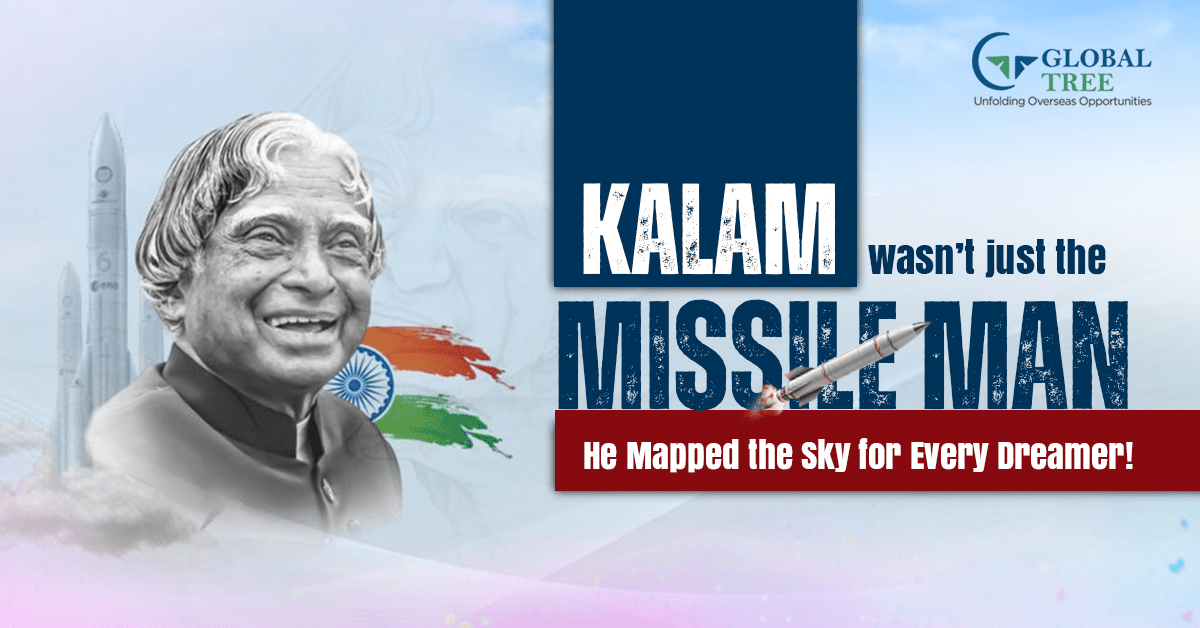Dr. A.P.J. Abdul Kalam – Life Story of Indias Visionary Leader

About A.P.J. Abdul Kalam
A.P.J. Abdul Kalam (born October 15 1931, in Rameswaram, India - died on July 27 2015, in Shillong) was an Indian politician and scientist who was a key player in India's nuclear weapons and missile programmes. Kalam is considered one of the best inspiring personalities of the world. He was the president of India from 2002 until 2007. His accomplishments in the field of science and fame led to him being nicknamed "Missile Man" as well as "People's president."
The beginning of life and a career
Kalam was born in a town within Tamil Nadu state to a fisherman who was part of an earlier prosperous family. Being the youngest of five children, Kalam persevered with his studies despite the poverty of his surroundings. He obtained a bachelor's diploma in aeronautical engineering at Madras Institute of Technology. Madras Institute of Technology, and in 1958, he joined the Defence Research and Development Organisation (DRDO). In 1969, he joined as a scientist at the Indian Space Research Organisation (ISRO), where he served as responsible for the project SLV-III, which was the first launch vehicle for satellites created and manufactured in India. In the year 1980, SLV-III succeeded in sending the satellite Rohini into orbit near Earth, which took India's space programs on the international scene. Kalam directed the developments in launch vehicle technology at ISRO and also that of the Polar Satellite Launch Vehicle.
Missile program
After joining DRDO at the time of his rejoining in 1982, Kalam created his Integrated Guided Missile Development Programme, which resulted in a variety of highly successful missiles. One of them was Agni, which was India's first intermediate-range ballistic missile, which included elements of the SLV-III and was released in 1989. A different success was the surface-to-surface strategic missile Prithvi.
You may also like: How to pursue aeronautical engineering for Indian students?
Nuclear tests
From 1992 until 1999, Kalam served as a scientific advisor to the defence minister of India, and later, he was the chief scientific advisor (1999-2001) in the government in the position of a cabinet minister. During this time, he was an integral part of the weaponization of missile systems, which gave India nuclear capability. In 1998, he was one of the principal organizers of the Pokhran II series of nuclear testing, where five bombs were set off at a testing range within the town of Pokhran, Rajasthan state. His role as a key player during the nation's nuclear weapons tests has established India as a nuclear power and also established Kalam as a hero of the country; however, the testing was a source of concern for the world community. In 1998, Kalam presented a national strategy dubbed Technology Vision 2020, which Kalam described as transforming India from a society that was not developed to one that was created in twenty years. In addition, the plan called for improving the productivity of agriculture, focusing on the use of technology to drive the development of the economy, as well as for expanding access to healthcare as well as education.
Suggested Read: Top 10 toughest exams in the world-what are they?
Presidency
The ruling party in India, the National Democratic Alliance (NDA), offered Kalam the title of the successor to the outgoing Prem. Kocheril Raman Narayanan. Kalam's fame and popularity proved so appealing that he was chosen for his party, the Hindu Nationalist (Hindutva) NDA; despite his being Muslim, the party was the most significant opposition, and the Indian National Congress proposed Kalam's candidacy.
Kalam effortlessly won the support of the electoral college, beating the former leader of the revolution, Lakshmi Sahgal. Kalam was inaugurated as the 11th Indian president, which is a mostly ceremonial position, at the end of July 2002. The president resigned after the expiration of his presidency in 2007 and was replaced by Pratibha Patil, who was India's first female president.
Legacy
After his return to civilian life, Kalam was determined to use technology and science to turn India into a more developed nation. He also served as a lecturer in a variety of institutions. He was a visiting professor at several campuses of the Indian Institute of Management and the founding chancellor of the Indian Institute of Space Science and Technology (Thiruvananthapuram).
(Check out: Top IIT colleges in India in 2025)
He was a great success engaging with kids and set out on a personal endeavour to interact with children, engage with them, and encourage youngsters.
On July 27, 2015. Kalam was struck by a fall while speaking an address at the Institute for Management of India, Shillong and died of heart failure shortly afterwards.
Kalam has written a number of books, among them his autobiography, Wings of Fire (1999), and also a book entitled "Ignited Minds (2002). The awards he received were three of India's top honours, which include the Padma Bhushan (1981) and the Padma Vibhushan (1990), as well as the Bharat Ratna (1997).
Read More: Discover the top 25 Highest-Paying jobs in the world
Numerous roadways, structures, and institutions bear the name Kalam. In 2015, the name of an area for missile tests in Odisha changed from Wheeler Island to Abdul Kalam Island. In 2017, a different species of bacterium was discovered in the International Space Station and was identified as Solibacillus Kalamii in honour of his name.
Conclusion
Dr. A.P.J. Abdul Kalam’s life story is a testament to the power of perseverance, humility, and vision. From his humble beginnings in Rameswaram to becoming India’s 11th President, he inspired millions with his relentless pursuit of knowledge and his dedication to the nation’s growth. Known as the "People’s President," his contributions to India’s space and defense sectors remain invaluable. Dr. Kalam’s legacy as a visionary leader continues to motivate individuals across generations to dream big, work hard, and serve humanity selflessly. His life is a shining example of how dedication, hard work, and a clear vision can transform not only a country but also the world.
Frequently Asked Questions
1. Who was Dr. A.P.J. Abdul Kalam?
Dr. A.P.J. Abdul Kalam was the 11th President of India, a renowned aerospace scientist, and a visionary leader. He is widely remembered for his contributions to India's missile and space programs, as well as his inspirational leadership style.
2. What are Dr. A.P.J. Abdul Kalam's major achievements?
Dr. Kalam's significant achievements include his role in the development of India's missile technology, his work as the Chief Scientific Advisor to the Indian government, and his efforts in making India a nuclear power. He also served as India's President from 2002 to 2007.
3. What was Dr. Kalam's contribution to India's space and defense programs?
Dr. Kalam played a pivotal role in India's space and defense programs, particularly in the development of the country's ballistic missile systems. He was instrumental in the success of the Pokhran-II nuclear tests in 1998 and the development of the Agni and Prithvi missiles.
4. What is Dr. Kalam's vision for India's future?
Dr. Kalam's vision for India was centered around transforming the country into a developed nation by 2020, with a focus on education, technology, and innovation. He emphasized youth empowerment and the need for a scientific and technology-driven future.
5. How did Dr. Kalam inspire India's youth?
Dr. Kalam was a strong advocate for youth education and encouraged them to dream big and work hard to achieve their goals. His speeches, books, and life experiences motivated millions of young Indians to pursue careers in science, technology, and leadership.
6. What was Dr. Kalam’s role as President of India?
As the President of India from 2002 to 2007, Dr. Kalam was known for his humble, approachable demeanor and his focus on encouraging youth. He emphasized the importance of education, development, and national pride during his tenure.
7. What are some of Dr. A.P.J. Abdul Kalam’s books?
Some of Dr. Kalam’s famous books include Wings of Fire (his autobiography), Ignited Minds, India 2020, The Life Tree, and My Journey. These books have inspired readers to think about progress, innovation, and personal growth.
8. What values did Dr. Kalam promote in his speeches?
Dr. Kalam promoted values such as perseverance, hard work, integrity, and self-reliance. He encouraged individuals to follow their passions and contribute to the nation’s progress through innovation and service.
9. How did Dr. Kalam contribute to India’s nuclear and defense program?
Dr. Kalam played a significant role in India’s nuclear program and its defense sector. His leadership in the successful testing of nuclear bombs during the Pokhran-II tests in 1998 and his contributions to missile technology were landmark achievements for India.
10. What is Dr. Kalam’s legacy?
Dr. Kalam’s legacy is built on his vision for India’s future, his contributions to science and technology, and his efforts to inspire the younger generation. He is fondly remembered as the "People’s President" and continues to influence countless lives with his teachings and works.





